When you consider the outfits in "The Shape of Water," you can't help but notice how they reflect the deeper themes of the film. Each character's attire, from Elisa's ethereal dresses to Strickland's stark suits, tells a story about their inner lives and the era they inhabit. The color choices are particularly striking, highlighting contrasts in emotion and status. But what challenges did the costume designer face in bringing this vision to life? Exploring these aspects reveals more than just clothing; it discloses the intricate artistry woven into the film's fabric.
Overview of Costume Design
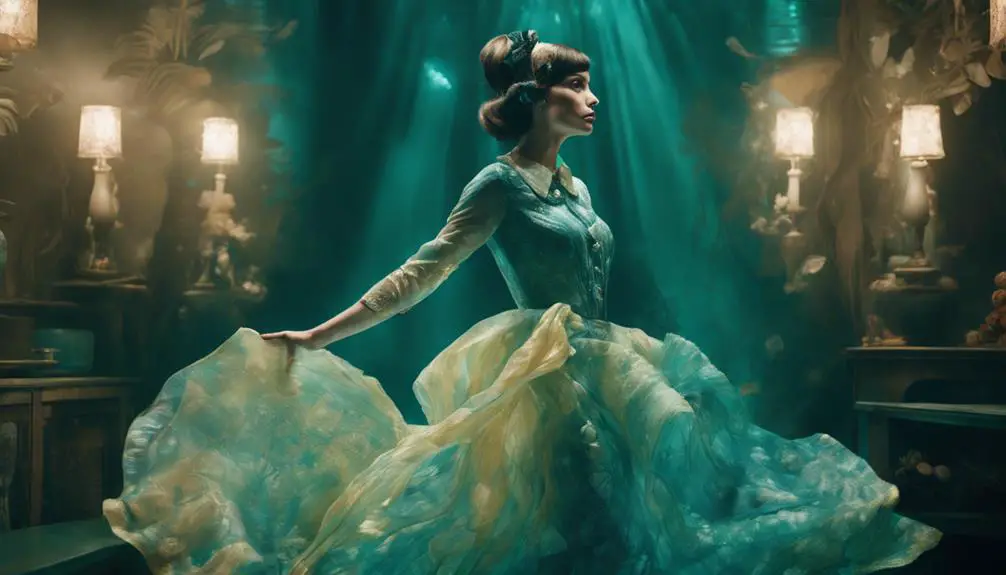
Drawing inspiration from a blend of whimsy and Cold War aesthetics, the costume design in "The Shape of Water" plays an essential role in enhancing the film's narrative. Led by costume designer Luis Sequeira, the costumes are meticulously crafted to reflect both the historical context and the fantastical elements of the story.
Sequeira collaborated closely with local artisans and tailors, ensuring that each character's costume wasn't only unique but also rich in detail. Elisa's iconic dress, for instance, features four layers of high-quality fabrics, including lace, chiffon, sequins, and crystals. This intricate layering evokes the movement and shimmer of 1930s and 1940s film aesthetics, perfectly aligning with her character's emotional journey.
The film's production designer also contributed to the overall vision, creating a Twilight Zone-like color palette that contrasts the muted tones of the oppressive environment with the vibrant colors representing Elisa's strength and individuality.
Significant budget allocation for key costumes, like Elisa's fantasy dress costing over CAD 10,000, underscores the importance of detailed craftsmanship in visual storytelling. Every element of the costume design enriches the film, drawing viewers deeper into its enchanting world.
Key Characters and Their Outfits
Costume design in "The Shape of Water" brings the key characters to life, each outfit reflecting their personality and role in the story. Take Elisa, the film's protagonist; her stunning dress, crafted with four layers of lace, chiffon, sequins, and crystals, emphasizes her graceful movement while showcasing her evolution and individuality. Inspired by 1950s fashion, it beautifully captures her journey from anonymity to empowerment.
The lab workers are dressed in muted colors, mirroring the oppressive atmosphere of the Cold War era, while Strickland's sharp, tailored suits stand in stark contrast to the earthy tones worn by the Russian characters, highlighting their distinct identities.
The creature's costume is particularly striking, featuring a unique design that accentuates its otherworldly nature, combining textures and colors that evoke both beauty and mystery.
Elisa's initial outfits blend into her surroundings, but the introduction of red signifies her growing strength and individuality as the story unfolds.
Each meticulously crafted costume, with some pieces costing over CAD 10,000, plays a vital role in enhancing the film's visual storytelling, allowing you to connect with the characters on a deeper level.
Color Palette and Symbolism
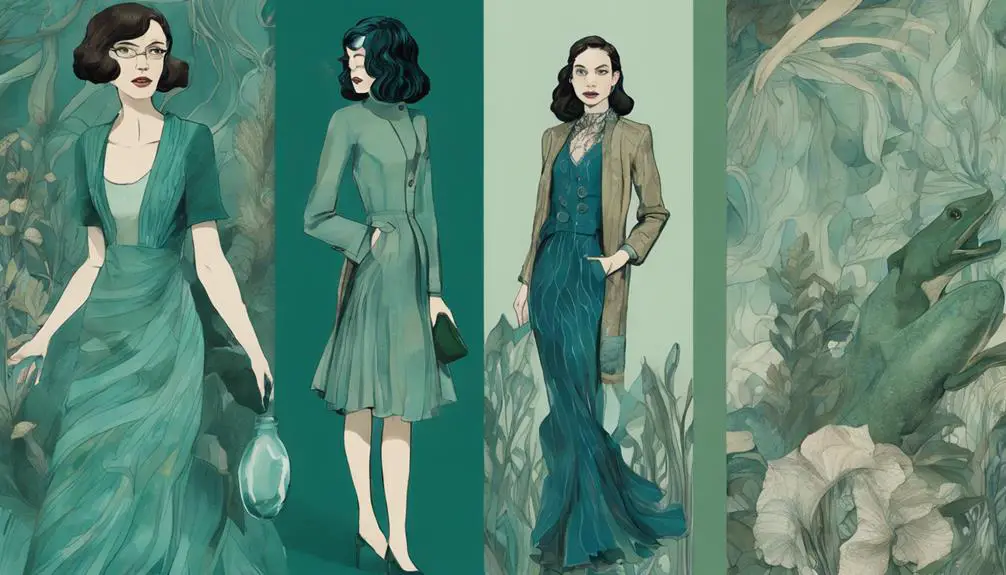
In "The Shape of Water," the color palette plays an essential role in shaping the film's emotional landscape and enhancing character development. You'll notice how muted tones dominate the lab workers' outfits, reflecting the oppressive atmosphere they inhabit, while Strickland's sharply tailored suits starkly contrast with the earthy colors of the Russian characters, highlighting their distinct identities.
At the heart of the film, Elisa's initial color palette is designed to help her blend into her surroundings, but as her journey unfolds, the introduction of red in her costumes symbolizes her growing strength and individuality.
The film's Twilight Zone-like color scheme evokes a nostalgic feel, with specific shades thoughtfully chosen to accentuate character arcs and emotional development. During dream sequences, costumes reference classic films like "Top Hat," employing color choices that resonate with the overarching themes and character evolution.
This overall color design not only enhances the visual storytelling but also plays a critical role in reflecting character identities and their emotional journeys. By paying attention to these subtle yet powerful elements, you can gain a deeper appreciation for how color and symbolism intertwine in this remarkable film.
Production Challenges and Solutions
The meticulous color palette and symbolism in "The Shape of Water" set a high standard for the film's production, especially in costume design. You'll find that the challenges faced by the costume team were vast, yet they handled them with impressive skill.
Budget constraints meant that every dollar counted, pushing the team to make precise decisions while guaranteeing quality remained intact. Collaboration with other departments was crucial; it helped guarantee that the costumes harmonized beautifully with the film's overall aesthetic and character environments.
Fabric selection proved to be another hurdle, as the team needed materials that reflected the film's historical period and characters' socioeconomic status. This was no small feat, requiring creativity and resourcefulness.
To add depth to the characters, the team utilized aging techniques, skillfully adding wear and tear to new garments, which created realistic, lived-in costumes that resonated with the film's narrative. The pressures to deliver high-quality work, all while adhering to the rigorous standards set by the production team, fostered a culture of excellence and precision.
Ultimately, these challenges were met with innovative solutions, resulting in costumes that not only looked stunning but also told a compelling story.
Luis Sequeira's Design Philosophy
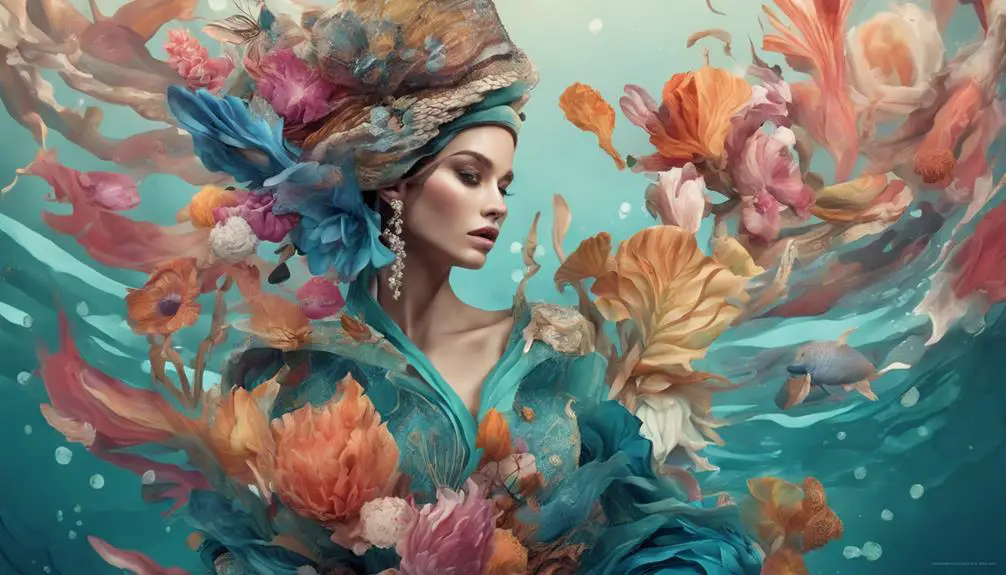
Drawing on a rich tapestry of historical references and imaginative elements, Luis Sequeira's design philosophy for "The Shape of Water" elevates storytelling through visual design. He emphasizes the integration of history with fantasy, making sure every costume tells a story that resonates with the characters' journeys.
Utilizing half-scale models, Sequeira meticulously crafts costumes with multiple fabric layers, incorporating high-quality materials adorned with shimmering Swarovski crystals. This attention to detail refines the costumes, ensuring they align seamlessly with character development and choreography.
His collaborative process with the director and production designer fosters a cohesive vision, reflecting the characters' environments and arcs. You can really see how Sequeira's costumes evoke emotions and themes, especially in Elisa's transformative look, where specific color palettes signify her evolution and individuality.
Recognized for blending fantasy with reality, Sequeira's innovative approach sets new standards in the industry. This inspires future designers to explore bold, character-driven concepts that resonate deeply with audiences.
In every stitch and layer, he helps provide our services to the storytelling process, processing your information through visual artistry that captivates and enchants.
Awards and Industry Impact
Luis Sequeira's innovative costume designs for "The Shape of Water" didn't just enhance the film's narrative; they also garnered significant recognition within the industry. Winning the Academy Award for Best Costume Design, Sequeira showcased a remarkable ability to blend fantasy and realism, setting a new standard for visual storytelling. Critics hailed his work for elevating the film's aesthetic, making each character's attire not just a costume but an essential part of their identity and the story itself.
The film's nominations for various accolades demonstrate its profound industry impact, inspiring upcoming designers to challenge the boundaries of costume design. Sequeira's creative collaboration with the cast and crew emphasized the importance of teamwork in achieving such a visually stunning result.
This approach encouraged a new generation of designers to explore bold concepts and character-driven designs, enhancing their artistry.
As you explore the world of "The Shape of Water," it's clear that the costume design has left an indelible mark on the industry, proving that thoughtful, imaginative attire can transform a film into a masterpiece. Sequeira's work will surely continue to influence and inspire future creative endeavors.
Frequently Asked Questions
Is the Girl in the Shape of Water Deaf?
Isn't it fascinating how silence can speak volumes? Yes, the girl in "The Shape of Water" is deaf. Her sign language communication enhances character development, creating profound emotional connections through visual storytelling that resonates deeply with viewers.
How Did They Film the Underwater Scenes in the Shape of Water?
To film underwater scenes, you'll notice the intricate choreography, innovative filming techniques, and special effects employed. The sound design enhances the experience, immersing you in the magical, dreamlike quality the director intended.
Is the Movie the Shape of Water Based on a True Story?
"The Shape of Water" isn't based on a true story. Instead, it weaves historical context, character inspiration, and thematic elements through Del Toro's creative process, crafting a fascinating tale of love and acceptance.
What Is the Point of the Movie Shape of Water?
The point of "The Shape of Water" is to tell a love story that challenges societal acceptance. It highlights isolation themes through its mythical creatures, showing how love bridges divides and transcends traditional boundaries.
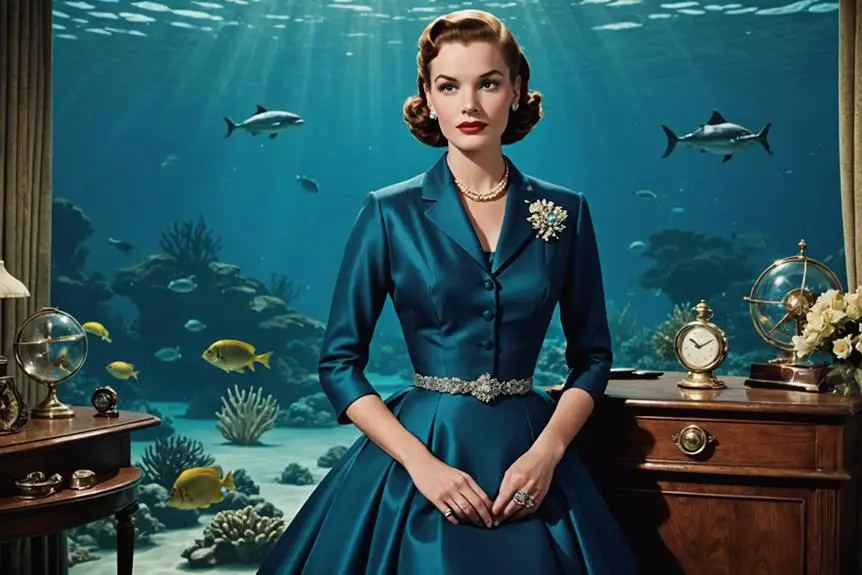



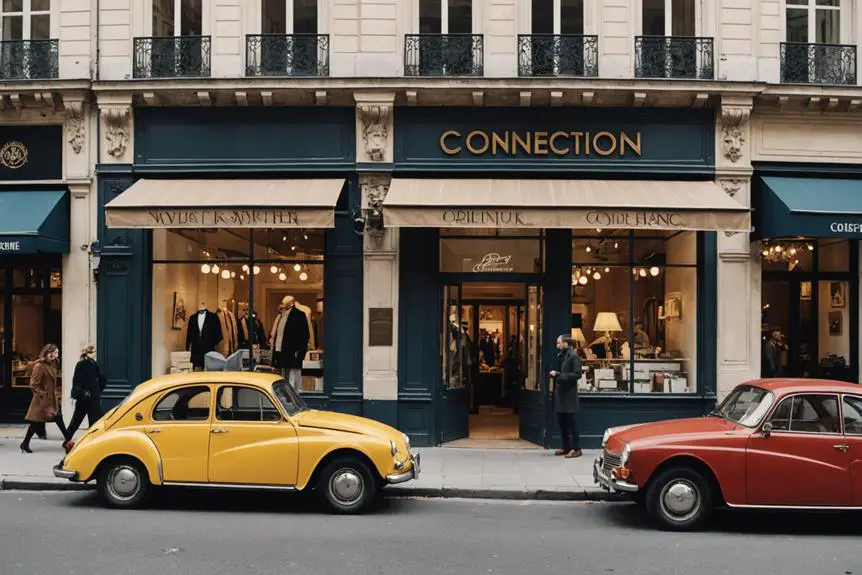
Great write ups Appreciate it.
web page
Thank you, Ample info.
casino en ligne
You stated that very well!
casino en ligne
Seriously plenty of useful material.
casino en ligne
Point nicely utilized.!
casino en ligne
Nicely put. Appreciate it.
casino en ligne
Very well expressed indeed! !
casino en ligne
Cheers. Excellent information!
casino en ligne
Regards, Great stuff!
casino en ligne
Superb info, Cheers!
casino en ligne